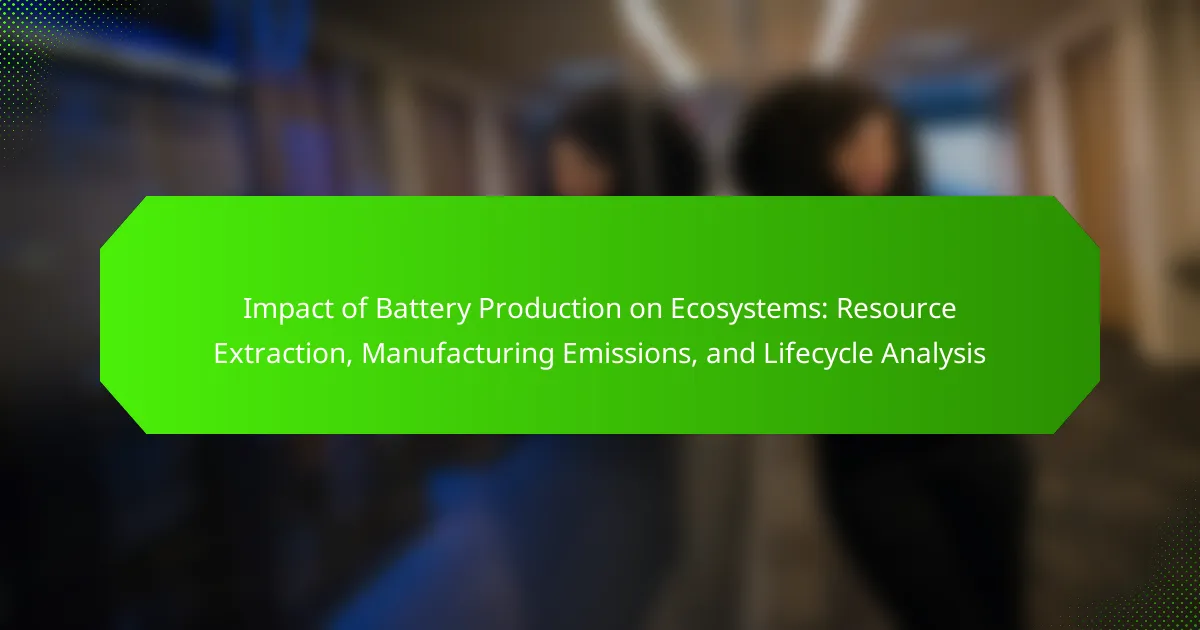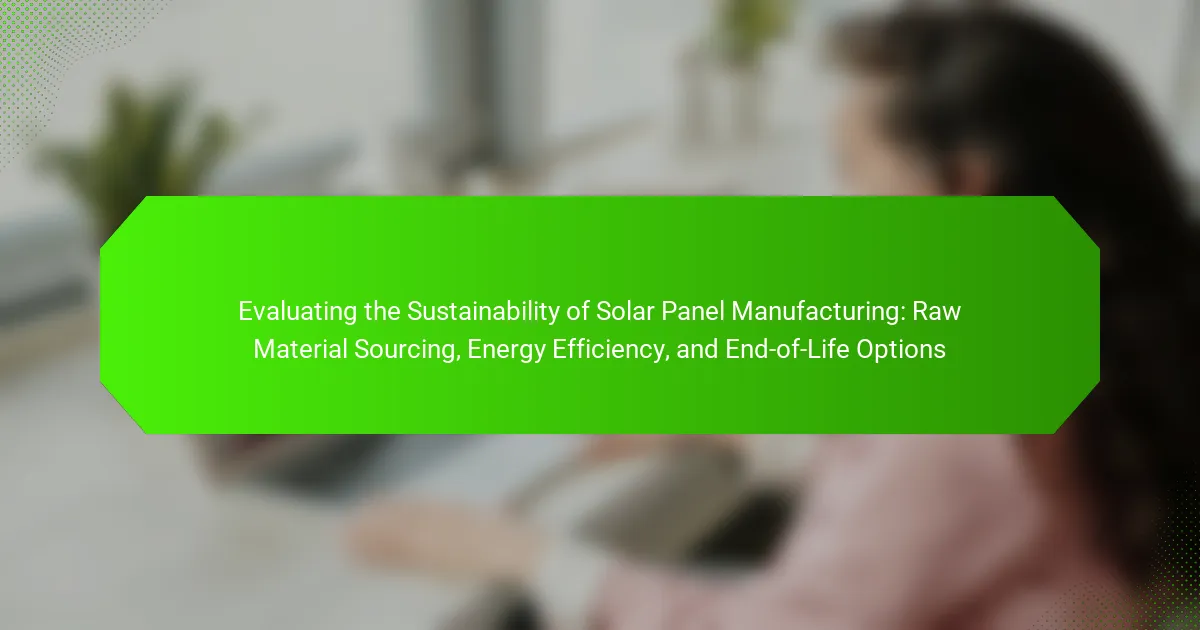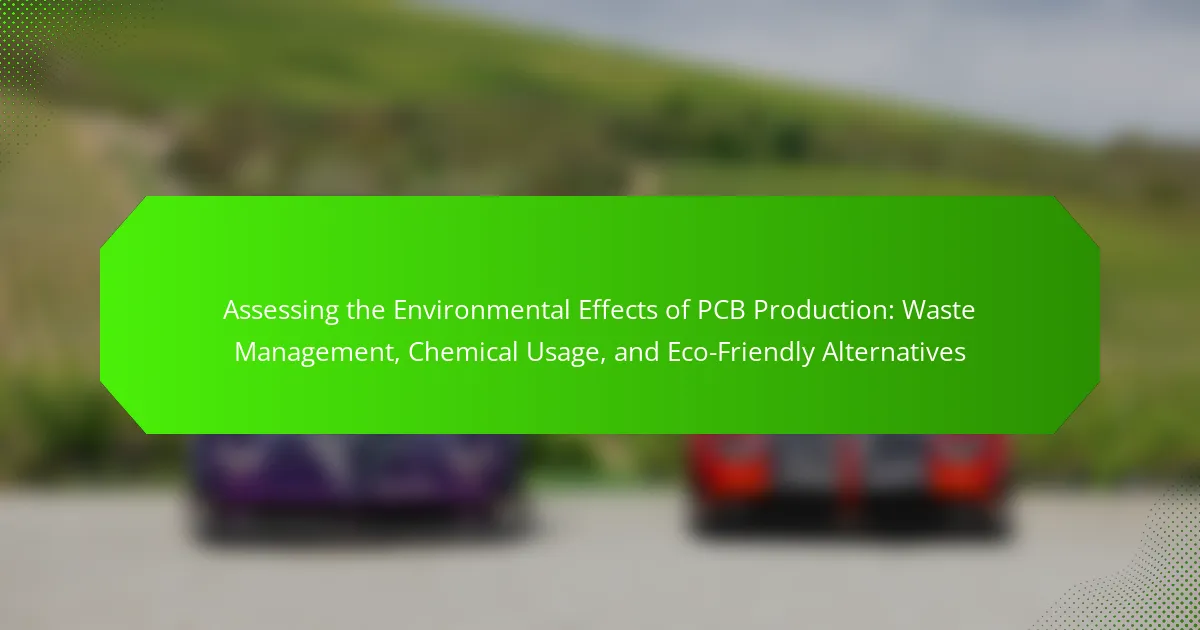Battery production significantly impacts ecosystems through resource extraction and manufacturing emissions. The extraction of raw materials such as lithium, cobalt, and nickel leads to habitat destruction, soil degradation, and water pollution, particularly in regions like South America where lithium mining depletes water resources. Manufacturing processes contribute to greenhouse gas emissions and generate toxic waste, posing risks to biodiversity and human health. Strategies to mitigate these ecological impacts include enhancing recycling processes, utilizing sustainable materials, and improving energy efficiency, which can collectively lead to a more sustainable battery production ecosystem.
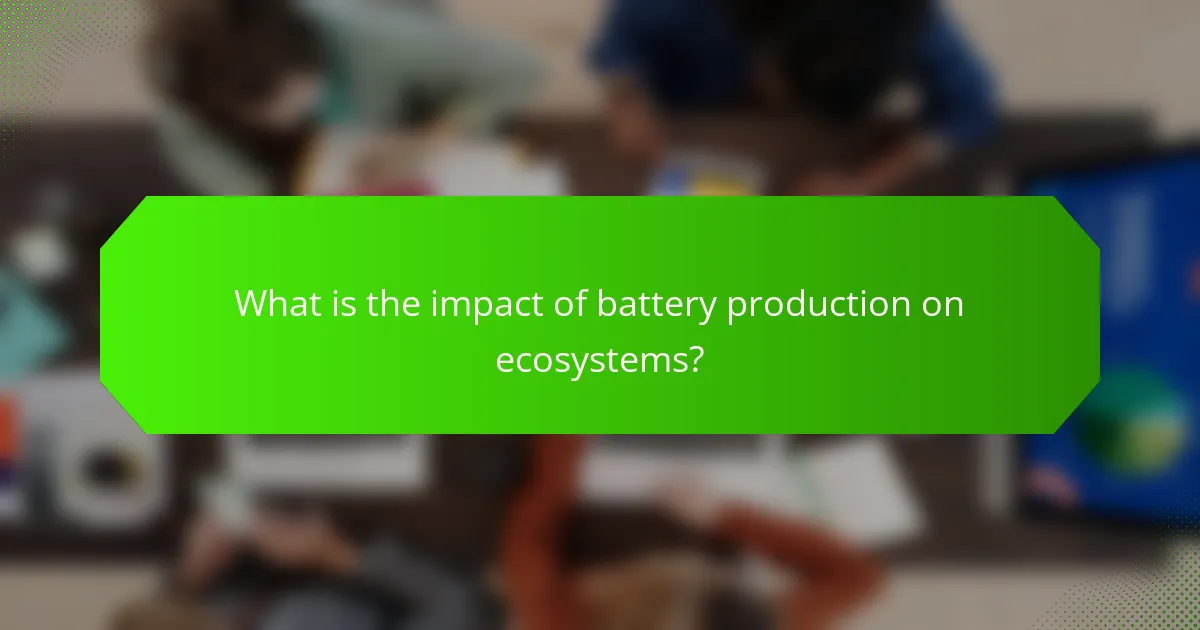
What is the impact of battery production on ecosystems?
Battery production negatively impacts ecosystems through resource extraction and manufacturing emissions. Mining for lithium, cobalt, and nickel leads to habitat destruction. This extraction process often results in soil degradation and water pollution. For instance, lithium mining in South America depletes water resources in arid regions. Manufacturing batteries emits greenhouse gases, contributing to climate change. The production process also generates toxic waste, which can contaminate local environments. Research indicates that the lifecycle of lithium-ion batteries can result in significant carbon footprints. Overall, battery production poses serious risks to biodiversity and ecosystem health.
How does resource extraction for battery production affect ecosystems?
Resource extraction for battery production significantly disrupts ecosystems. This process often involves mining for metals like lithium, cobalt, and nickel. Mining activities lead to habitat destruction and loss of biodiversity. Soil erosion and water contamination frequently occur due to these operations. Additionally, the use of heavy machinery contributes to noise pollution and further ecological disturbance. According to a study published in “Nature Sustainability,” lithium extraction can deplete local water sources, impacting surrounding flora and fauna. Furthermore, the removal of vegetation during mining exacerbates climate change effects by reducing carbon sequestration. Overall, these factors illustrate the negative impact of resource extraction on ecosystems.
What types of resources are extracted for battery production?
Lithium, cobalt, nickel, and graphite are the primary resources extracted for battery production. Lithium is essential for lithium-ion batteries, which are widely used in electronics and electric vehicles. Cobalt is often used to enhance battery stability and energy density. Nickel contributes to increasing energy capacity and longevity. Graphite serves as the anode material in most lithium-ion batteries. These materials are sourced from various mining operations around the world, often involving significant environmental impacts. For example, lithium extraction can lead to water depletion in arid regions, while cobalt mining has been linked to human rights issues.
What environmental consequences arise from resource extraction?
Resource extraction leads to significant environmental consequences. Deforestation occurs as forests are cleared for mining and drilling activities. This loss of vegetation disrupts ecosystems and contributes to biodiversity decline. Soil erosion is another consequence, as the removal of vegetation destabilizes soil layers. Water pollution often results from the runoff of chemicals used in extraction processes. Additionally, air quality deteriorates due to dust and emissions from machinery. Habitat destruction is prevalent, endangering species that rely on specific environments. Climate change is exacerbated as fossil fuels are extracted and burned, increasing greenhouse gas emissions. These impacts highlight the urgent need for sustainable practices in resource extraction.
What are the manufacturing emissions associated with battery production?
Manufacturing emissions associated with battery production primarily include carbon dioxide, sulfur dioxide, and particulate matter. Battery production processes, especially for lithium-ion batteries, generate significant greenhouse gases. For instance, producing one kilogram of lithium-ion battery cells can emit approximately 150 to 200 kilograms of CO2 equivalent. Emissions stem from mining raw materials, refining metals, and energy-intensive manufacturing processes. The extraction of lithium, cobalt, and nickel is particularly emission-heavy. Studies show that the carbon footprint of battery production is substantial compared to traditional vehicle manufacturing. Lifecycle assessments indicate that emissions can vary widely based on energy sources used in production. Transitioning to renewable energy in manufacturing could reduce these emissions significantly.
How do manufacturing processes contribute to pollution?
Manufacturing processes contribute to pollution primarily through the release of harmful emissions and waste. Factories emit greenhouse gases like carbon dioxide and methane during production. These emissions contribute to climate change and air quality degradation. Additionally, manufacturing often involves the use of toxic chemicals that can contaminate water sources. For example, heavy metals from battery production can leach into groundwater. Solid waste generated in manufacturing can also lead to land pollution if not properly managed. According to the Environmental Protection Agency, industrial processes account for a significant portion of total emissions in many regions. Overall, the environmental impact of manufacturing processes is substantial and multifaceted.
What types of emissions are generated during battery manufacturing?
Battery manufacturing generates several types of emissions. These include greenhouse gases, particulate matter, and volatile organic compounds. Greenhouse gases such as carbon dioxide and methane are released during the extraction and processing of raw materials. Particulate matter is emitted from energy-intensive manufacturing processes. Volatile organic compounds are released from solvents used in battery production. Studies indicate that battery production can emit significant amounts of carbon dioxide, with estimates ranging from 60 to 100 kg of CO2 per kWh of battery capacity. The emissions contribute to air pollution and climate change, impacting ecosystems.
How does lifecycle analysis contribute to understanding battery production’s impact?
Lifecycle analysis evaluates the environmental impacts of battery production across its entire lifespan. It examines resource extraction, manufacturing, usage, and disposal phases. This comprehensive view helps identify critical areas for improvement. For example, it quantifies greenhouse gas emissions during manufacturing. A study by the International Energy Agency reported that battery production contributes significantly to overall emissions. Lifecycle analysis also assesses resource depletion, highlighting the need for sustainable sourcing of materials. By mapping these impacts, stakeholders can make informed decisions to reduce the ecological footprint of batteries. This approach fosters innovation in recycling and alternative materials, ultimately supporting a more sustainable battery production process.
What stages are included in a lifecycle analysis of batteries?
A lifecycle analysis of batteries includes several key stages. These stages are raw material extraction, manufacturing, usage, and end-of-life disposal or recycling.
Raw material extraction involves mining for essential components like lithium, cobalt, and nickel. Manufacturing refers to the processes used to produce the batteries, which can generate emissions and waste. Usage encompasses the period during which the battery powers devices or vehicles. End-of-life disposal or recycling focuses on how batteries are managed after their useful life, impacting environmental sustainability.
These stages help assess the overall environmental impact of battery production and usage.
How do different battery technologies compare in lifecycle impact?
Different battery technologies exhibit varying lifecycle impacts based on resource extraction, manufacturing emissions, and end-of-life management. Lithium-ion batteries, widely used in electric vehicles, have significant environmental concerns due to lithium mining and high energy consumption during production. In contrast, lead-acid batteries are less resource-intensive but have hazardous waste issues related to lead.
Nickel-metal hydride batteries, while offering better energy density, still face challenges with nickel extraction and recycling. Solid-state batteries promise lower environmental impact due to reduced reliance on harmful materials but are not yet commercially viable at scale.
Lifecycle assessments indicate that lithium-ion batteries contribute approximately 150 kg CO2 equivalent emissions per kWh during production, while lead-acid batteries range around 100 kg CO2 equivalent per kWh. The differences in lifecycle impact highlight the importance of choosing sustainable battery technologies to minimize ecological damage.
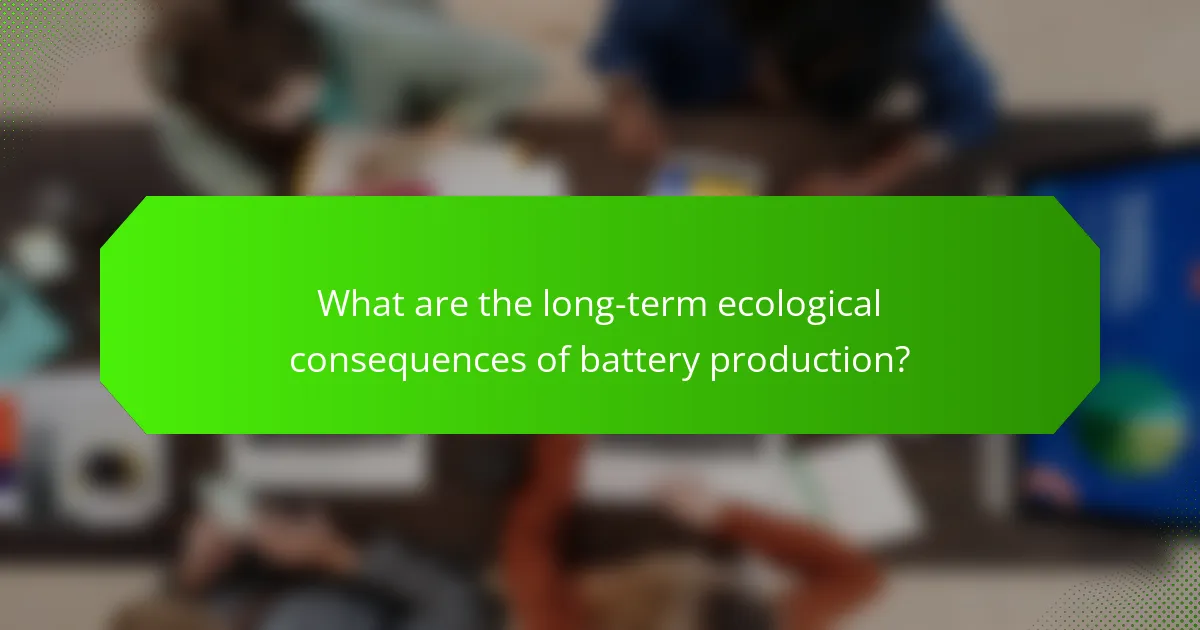
What are the long-term ecological consequences of battery production?
Battery production has significant long-term ecological consequences. The extraction of raw materials, such as lithium and cobalt, leads to habitat destruction and biodiversity loss. Mining operations often result in soil degradation and water contamination. Manufacturing emissions contribute to air pollution, affecting both local ecosystems and global climate change. Additionally, improper disposal of batteries can release toxic substances into the environment. Studies show that these factors can lead to long-lasting negative effects on ecosystems and human health. For instance, a report by the International Energy Agency highlights how battery production can increase greenhouse gas emissions significantly. Overall, the ecological impact of battery production is profound and requires careful management and regulation.
How does battery waste management affect ecosystems?
Battery waste management significantly affects ecosystems by preventing harmful chemicals from contaminating soil and water. Improper disposal of batteries can lead to the leaching of toxic substances such as lead, cadmium, and mercury. These heavy metals can harm plant and animal life, disrupting local food chains. Additionally, contaminated water sources can pose risks to human health. Effective recycling programs can recover valuable materials and reduce the need for new resource extraction. Research shows that proper battery disposal can decrease environmental pollution and promote sustainability. For example, the Environmental Protection Agency (EPA) emphasizes the importance of recycling to mitigate ecological damage.
What are the risks associated with improper battery disposal?
Improper battery disposal poses several risks to the environment and human health. Batteries contain toxic substances such as lead, cadmium, and mercury. When disposed of in landfills, these materials can leach into soil and groundwater. This contamination can harm local ecosystems and drinking water sources.
Additionally, improper disposal can lead to chemical reactions that cause fires or explosions. The Environmental Protection Agency (EPA) states that battery fires can release hazardous fumes into the air. These fumes can contribute to air pollution and respiratory issues in nearby populations.
Moreover, improper disposal undermines recycling efforts. Recycling batteries helps recover valuable materials and reduces the need for new resource extraction. According to a study by the International Energy Agency, effective recycling can reclaim up to 95% of lithium from lithium-ion batteries.
In summary, the risks associated with improper battery disposal include environmental contamination, health hazards, and lost recycling opportunities.
How can recycling practices mitigate environmental harm?
Recycling practices can significantly mitigate environmental harm by reducing waste and conserving resources. By recycling batteries, harmful materials are kept out of landfills. This process minimizes soil and water contamination from toxic substances. Recycling also decreases the need for raw material extraction. For instance, recycling lithium-ion batteries can recover up to 95% of lithium. This reduces the environmental impact associated with mining operations. Furthermore, recycling lowers greenhouse gas emissions. The energy required for recycling is often less than that needed for new production. Overall, these practices contribute to a more sustainable ecosystem.
What role do regulations play in minimizing the impact of battery production?
Regulations play a crucial role in minimizing the impact of battery production. They set standards for environmental protection during resource extraction and manufacturing processes. Regulations limit harmful emissions from production facilities. They also mandate the safe disposal and recycling of battery materials. For example, the European Union’s Battery Directive aims to reduce waste and encourage recycling. Compliance with these regulations can lead to reduced ecological damage. Studies show that stricter regulations lead to cleaner production technologies. Overall, regulations ensure that battery production is more sustainable and less harmful to ecosystems.
What are current regulations governing battery production and disposal?
Current regulations governing battery production and disposal include various laws and guidelines aimed at minimizing environmental impact. The Resource Conservation and Recovery Act (RCRA) regulates hazardous waste, including batteries, in the United States. The European Union’s Battery Directive sets requirements for battery design, labeling, and recycling.
These regulations mandate the collection and recycling of spent batteries to prevent environmental contamination. For instance, manufacturers must ensure proper disposal methods and promote recycling initiatives. Additionally, many states have enacted laws that require battery recycling and impose penalties for non-compliance.
These regulations are crucial for reducing toxic waste and promoting sustainable practices in battery lifecycle management.
How effective are these regulations in protecting ecosystems?
The effectiveness of regulations in protecting ecosystems is significant but varies by context. Regulations aim to mitigate environmental impacts from battery production. They set limits on emissions and resource extraction practices. For example, regulations can reduce toxic waste from manufacturing processes. In the European Union, the Battery Directive mandates recycling and responsible sourcing. Studies indicate that such regulations have led to a decrease in harmful emissions. The effectiveness is also influenced by enforcement and compliance levels. Ultimately, while regulations are effective, ongoing evaluation and adaptation are necessary.
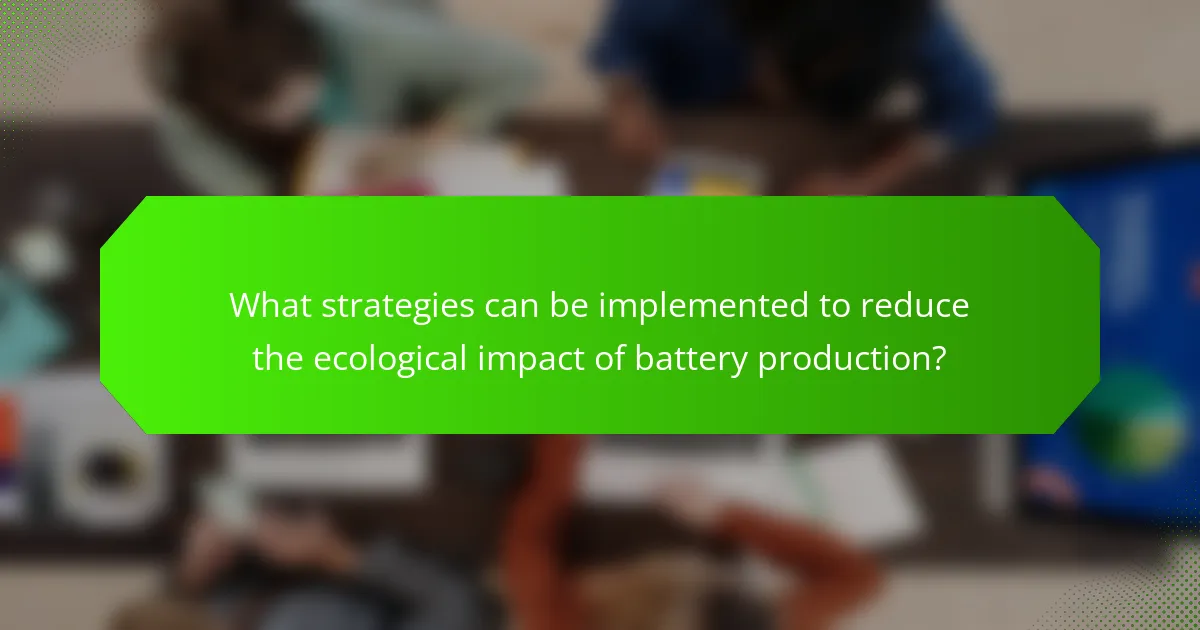
What strategies can be implemented to reduce the ecological impact of battery production?
Implementing strategies to reduce the ecological impact of battery production includes enhancing recycling processes, utilizing sustainable materials, and improving energy efficiency. Recycling can recover valuable metals, reducing the need for new resource extraction. According to the International Energy Agency, recycling lithium-ion batteries can recover up to 95% of lithium and cobalt. Utilizing sustainable materials, such as bio-based alternatives, can minimize environmental harm. Energy-efficient manufacturing processes can cut emissions significantly. For instance, using renewable energy sources during production can lower carbon footprints. Additionally, adopting closed-loop systems can reduce waste and pollution. These strategies collectively contribute to a more sustainable battery production ecosystem.
How can sustainable practices be integrated into battery production?
Sustainable practices can be integrated into battery production by adopting eco-friendly materials and processes. Utilizing recycled materials for battery components reduces resource extraction. Implementing renewable energy sources in manufacturing lowers carbon emissions. Optimizing production efficiency minimizes waste generation. Establishing closed-loop recycling systems allows for the recovery of valuable materials. Companies can also adhere to strict environmental regulations to mitigate ecological impacts. Research shows that these practices can significantly reduce the overall carbon footprint of battery production. For instance, a study by the International Energy Agency highlights the benefits of using sustainable sourcing methods.
What are the benefits of using renewable resources in battery manufacturing?
Using renewable resources in battery manufacturing reduces environmental impact. It decreases carbon emissions associated with fossil fuel extraction. Renewable resources often require less energy during production. This leads to lower overall greenhouse gas emissions. For instance, using bio-based materials can cut emissions by up to 50%. Renewable resources are also more sustainable over time. They can be replenished naturally, unlike finite fossil fuels. This approach promotes resource conservation and helps mitigate climate change. Additionally, it can enhance the lifecycle sustainability of batteries.
How can innovations in battery technology reduce environmental impact?
Innovations in battery technology can significantly reduce environmental impact by improving energy density and recycling processes. Higher energy density allows for smaller batteries, which reduces material usage and waste. Advanced recycling methods reclaim valuable materials, minimizing the need for new resource extraction. For instance, lithium-ion batteries can be recycled to recover up to 95% of lithium and cobalt. Additionally, solid-state batteries eliminate the use of harmful electrolytes, enhancing safety and reducing toxic waste. Research shows that optimizing battery life cycles can lower greenhouse gas emissions by 30% compared to traditional batteries. These advancements collectively contribute to a more sustainable battery ecosystem.
What are best practices for consumers regarding battery use and disposal?
Consumers should follow specific best practices for battery use and disposal. First, they should charge batteries according to manufacturer instructions to maximize lifespan. Overcharging can lead to reduced efficiency and potential hazards. Second, consumers should avoid exposing batteries to extreme temperatures. High heat can cause leakage or rupture, while cold can reduce performance.
When disposing of batteries, consumers must not throw them in regular trash. Many batteries contain toxic materials that can harm the environment. Instead, they should utilize designated recycling programs. According to the Environmental Protection Agency, recycling batteries prevents hazardous substances from entering landfills.
Local recycling facilities often accept batteries for proper disposal. Additionally, some retailers offer battery take-back programs. These practices help ensure safe handling and reduce environmental impact. By following these guidelines, consumers contribute to a more sustainable ecosystem.
How can consumers responsibly dispose of batteries?
Consumers can responsibly dispose of batteries by taking them to designated recycling centers. Many local governments and retailers offer battery recycling programs. These programs ensure that batteries are processed safely and do not harm the environment. According to the Environmental Protection Agency, recycling batteries can recover valuable materials and reduce pollution. Consumers should avoid throwing batteries in regular trash. Improper disposal can lead to toxic leaks and environmental contamination. Following local guidelines for battery disposal is crucial for responsible recycling.
What steps can consumers take to support sustainable battery options?
Consumers can support sustainable battery options by choosing batteries with eco-friendly certifications. Look for labels like Energy Star or other sustainability marks. Purchasing rechargeable batteries reduces waste and encourages a circular economy. Consumers should also dispose of batteries properly by using recycling programs. Supporting companies that prioritize sustainable sourcing and manufacturing practices is crucial. Research brands that use recycled materials in their batteries. Staying informed about battery technologies can guide better purchasing decisions. Engaging in advocacy for battery recycling initiatives can further promote sustainability.
The main entity of this article is battery production and its impact on ecosystems. The article examines the negative consequences of resource extraction, particularly for lithium, cobalt, and nickel, which lead to habitat destruction, soil degradation, and water pollution. It also discusses manufacturing emissions that contribute to climate change and pollution, highlighting the lifecycle analysis of batteries to understand their ecological footprint. Additionally, the article addresses the importance of recycling practices, regulations, and sustainable strategies to mitigate the environmental harm associated with battery production.
